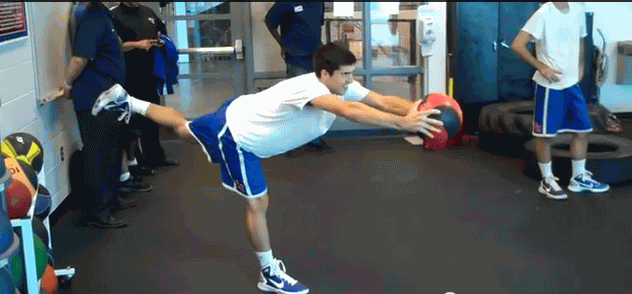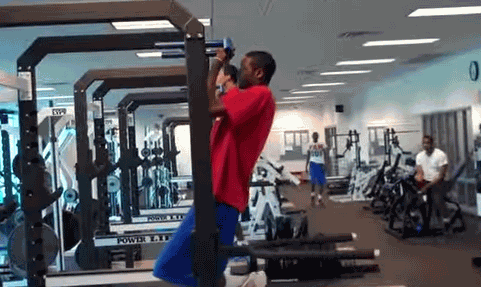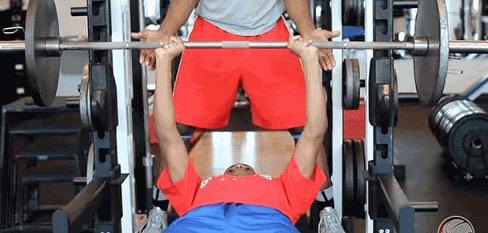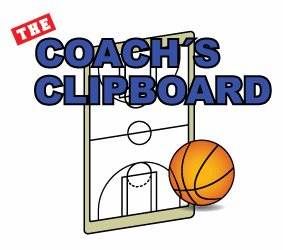Basketball In-Season Strength Training, by Thomas Emma
From the Coach’s Clipboard Basketball Playbook"Helping coaches coach better..."
Tom Emma was a graduate of Duke University, where he was a three-year basketball starter and captain his senior year, and was later drafted by the Chicago Bulls in 1983. He held a Masters degree from Columbia University, specialized in sports conditioning, was the owner of Power Performance, Inc. and published several books. Tom authored several other articles on this website. Sadly (after the original posting of this article), Tom died on June 8, 2011... Coach Gels.
While strength training is obviously a staple of any serious basketball player's year-round improvement program today, it wasn't always the case. There was a time not all that long ago when working out in the weight room was taboo for hoopsters. The prevailing "wisdom" was that strength training would build unnecessary body weight and tighten muscles, thus slowing the player down and hindering shooting touch and ball handling ability.
Additionally, and certainly unthinkable today, many so-called experts of yesteryear believed that lifting weights regularly would increase an athlete's susceptibility to injury (even a novice, contemporary follower of sports knows that strengthening the body helps to prevent injury not cause it).

Fortunately, the basketball world has slowly but surely come to its collective senses concerning strength training. It started initially with big men (power forwards and centers) who needed added bulk and strength in order to hold position in the post and mix it up under the boards. Shortly thereafter small forwards and guards got into the strength training act, firmly establishing weightlifting as a performance enhancing tool for basketball players.
However, their was one aspect of basketball strength training that lagged the pack. Strength workouts were more often than not only prescribed for the off-season months. In season strength work was discouraged for the most part. The feeling was that adding additional physical activity in the form of strength training to already demanding practice sessions and games would be too much for players to handle.
Finally, and not a moment too soon if you ask me, strength work became a year-round affair for all basketball players, with cagers lifting consistently not only in the off-season but throughout the competitive campaign as well. This change of heart toward in season lifting has allowed basketball players to maintain their hard earned strength gains on a season long basis.
It has been estimated that elite athletes incur noticeable strength loss in as little as three weeks after the discontinuation of strength training. For basketball players in the midst of a season this may happen faster and deeper because of all the up and down running, jumping, and cutting required when playing the game.
As such, in season strength training has become at least as important as the off season variety and is now a prerequisite for basketball athletes at all levels of play from middle school on up though the professional ranks. Listed and explained below are numerous ideas and strategies that coaches and their staffs can incorporate in order to make in season basketball strength programs as efficient and successful as possible. Good luck!
Plan! Plan! Plan!
Every experienced basketball coach and strength and conditioning specialist is well aware of how difficult it is to plan and implement an in season strength training program. Numerous variables must be taken into account, including, but not limited to, player fatigue, travel snags, injuries, facility availability, media/alumni responsibilities and unexpected schedule changes.
As such, it is essential that coaches and strength and conditioning personal meet prior to each season and, after carefully studying the game and travel schedules for the upcoming campaign, devise a season long team strength training itinerary for their players. Chances are, of course, this schedule will have to be updated and fine tuned from week to week, but beginning with a blueprint will serve your team well. Coaches may also want to caucus weekly with their strength and conditioning staff and team trainers as the season progresses in order to maintain strength program continuity.
In addition to comprehensive planning by coaches and strength and conditioning staff, players should be strongly encouraged to keep accurate records concerning their own individual strength workouts. Maintaining a training log, especially during the busy in season months, will help keep athletes organized and focused on strength training when their minds are otherwise engaged on upcoming games, practices, wins, loses, playing time, etc. The entries in a strength training log should at a minimum include the exercises used, number of total sets per workout, weight/repetitions incorporated per set, workout duration, and energy level during the training session.
Use Only Multi-Joint Exercises
Multi-joint exercises (movements that incorporate more than one joint and train multiple muscle groups at once) will be the focal point of your team's year-round strength training program. Because of their efficiency, multi-joint movements such as bench presses, squats, dead lifts, and chin-ups should be used exclusively during in-season strength sessions. While there is a place, albeit relatively small, for single-joint exercises (arm curls, leg extensions, etc.) in your overall strength routine, their use should be limited to the off-season when more time and energy are available for the weight room.
For in season basketball strength workouts I try to always choose exercises that stimulate the largest number of muscle groups possible. This more bang for your buck (or more bang for your exercise) theory has proved very successful in maintaining in season strength for the basketball athletes I train. I feel strongly that this approach will do the same for your players.
Before closing this section, I want to touch on a group of multi-joint exercises usually referred to as explosive, Olympic style lifts. These movements, which have become extremely popular in the sports conditioning world in recent years, include power cleans, snatches, high pulls, among others. If they are part of your team's strength training program, you must decide whether or not to incorporate them during the competitive campaign.
Olympic style lifts, while very effective for building explosive power and overall body strength, are also very taxing on the nervous system. As such, some strength and conditioning specialists discourage their use during the physically demanding regular season. The sentiment being that their use would fatigue athletes unnecessarily, causing on court performance deterioration and raising injury risk.
My feeling is that explosive movements can and should be incorporated during the regular basketball season. But, and I emphasize the word but, they must be used judiciously. This means keeping the weight reasonable, perhaps 70 % or so of your off-season poundage; never engaging in more than one explosive-oriented workout per week during the season; and in the event of a heavy game schedule week avoiding explosive lifts completely.

Strength Maintenance
Strength maintenance is the one and only goal of a basketball in season strength program. Because of the tremendous physical, mental, and time demands of a basketball season, it is virtually impossible for players, especially those who log large amounts of minutes on the floor, to increase strength.
In fact, just maintaining strength is very difficult for the majority of players over the course of the regular season regardless of how hard and conscientiously they work in the weight room. Notwithstanding, strength maintenance is a worthy objective, one that coaches, strength and conditioning staff, and players should work together to achieve.
Remember, Not All Players Were Created Equal When it Comes to Strength Training
As most coaches, athletic trainers, and strength and conditioning specialists know, all athletes do not respond the same to training stimulus. This is especially true when it comes to recovering from strength training workouts. Some like all-time great Michael Jordan are able to bounce back almost immediately from a strength session. (Jordan was known to lift weights on game days with no ill effects to his performance on the court.)
While others, the majority, need a full 48 hours or more to recover fully from an intense strength workout. As such, coaches, and especially strength and conditioning personal, should careful observe and monitor how individual players respond to strength training. This is best accomplished in the off season when competitive games are not a factor.
From there, the information gathered can be used to plan appropriate in season strength programs for each individual player. Because recovery is of paramount importance during the competitive campaign, this player by player research is a must if you hope to have a successful, performance promoting in season strength program.
Keep Players on a Regular Strength Training Schedule Prior to Game Play
Most basketball teams outside of the NBA have three to four weeks of preseason practice prior beginning their regular season schedules. These early weeks will be filled with intense practice sessions which focus on fine tuning skills, conditioning and developing team chemistry. It is also the time when roster spots and playing time are determined.
While player energy will be depleted during this time of year because of the demanding practice sessions, it will be much less so than when the regular game schedule begins (adding travel and game stress to the mix depletes energy considerably). As such, coaches and strength and conditioning staff should make sure that their athletes remain consistent in the weight room over these important preparatory weeks.
Two to three reasonably hard strength training workouts per week during this time is suggested. The workouts themselves will as closely as possible resemble those undertaken in the off season-although the weight incorporated will likely be less due to the above mentioned energy draining practices. This approach will pay great dividends as players move on through the heart of the long, grueling basketball campaign.
Strength Train Immediately Following Games
I learned about strength training after games from my Duke teammate, former NBA standout center, and current college basketball commentator, Mike Gminski. Big Mike, along with our team strength coach, would hustle to the weight room immediately following each and every home contest for a post game lift. They would do the same after road games if the appropriate facilities were convenient and available.
Strength training immediately following games is a terrific way to keep current with player strength programs. It allows for extra recovery before the next competition and has the added benefit of helping to cool the body down after the intense exertion of a ball game. Cooling down efficiently promotes relaxation and sound sleep, both very important and difficult to achieve after an intense basketball game. Additionally, this type of workout brings a tremendous sense of individual and team satisfaction, as players realize that they are going the extra mile in the name of improvement.
Post game workouts should be accomplished immediately following the game while the body is still reasonably warm. (Letting the body cool down too much will adversely effect workout quality and leave players susceptible to injury.) The sessions themselves will be relatively short in duration-no longer than 30 to 35 minutes.
The weight incorporated should be on the light side (remember a game was just played)! It is important that players remain optimally hydrated before, during, and after the workout. Finally, if an injury of any kind was sustained during the game make sure to have it looked at by the appropriate personal prior to beginning the strength session.
Of course, post game strength workouts are contingent upon access to the necessary facilities. The majority of high schools and colleges now have weight rooms that can be used at all hours. However, this will usually require some planning ahead. As such, coaches, trainers, and strength and conditioning personal should arrange for the use of a weight room in advance. In the event that a facility is unavailable, engaging in a body weight workout is suggested, using exercises such as push-ups, bench/chair dips, body weight squats and lunges, pull-ups, and crunches.

Take Advantage of Breaks in the Schedule for Strength Training
Though rare, you will sometimes find that your schedule calls for a fairly substantial (6 to 10 day) break from game play. This can occur over the Christmas/New Years holiday, during exams at the end of the fall semester, and/or between the conclusion of the regular season and the commencement of post season play. Whenever a break presents itself, it is a tremendous opportunity for players to hit the weights hard.
Getting three to five solid strength training sessions in without the physical and mental stress of competition can do wonders for player's in season strength maintenance. So check your schedule at the beginning of the season, and if you notice a long break in game action, plan to have your players take full advantage of it in the weight room.
Schedule a Team Strength Workout Periodically in Lieu of Practice
In my college playing days at Duke University I was very fortunate to play for two coaches who were creative thinkers. Both Coach K and Bill Foster before him had an instinctive feel for when a team as a whole needed a change of pace.
One way they would break the tedium is by holding a team strength workout in lieu of regular practice (they also from time to time substituted volleyball games and half court shooting contests for conventional practice sessions as well)! This approach gave the team a welcome mental break from the monotony of practice, while at the same time allowing players to maintain their strength programs (as mentioned, no easy task during the busy regular season).
Coaches at all levels would be well served experimenting with this type of alternate to practice from time to time. Since the day will be dedicated exclusively to strength training without any basketball related activities, I recommend that players train as intensely as possible in order to get the most out of the lifting session.
Get as Strong as Possible During the Off Season
Perhaps the best way to ensure that players remain strong for the duration of the basketball season is to encourage them to develop as much strength as possible during the off season months. Ideally, players should be at their strongest on the first day of regular season practice. Year-round strength programs should be designed to achieve this objective.
Related page: Basketball Training Drills from Alan Stein



